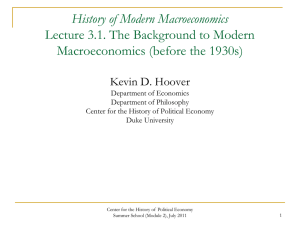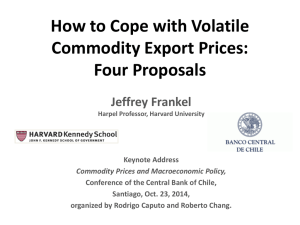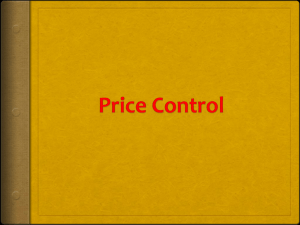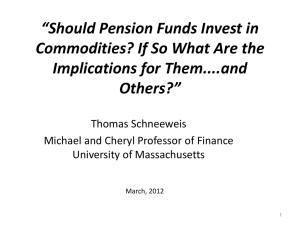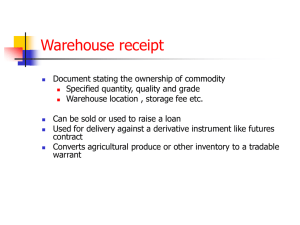PowerPoint Slide Here
advertisement
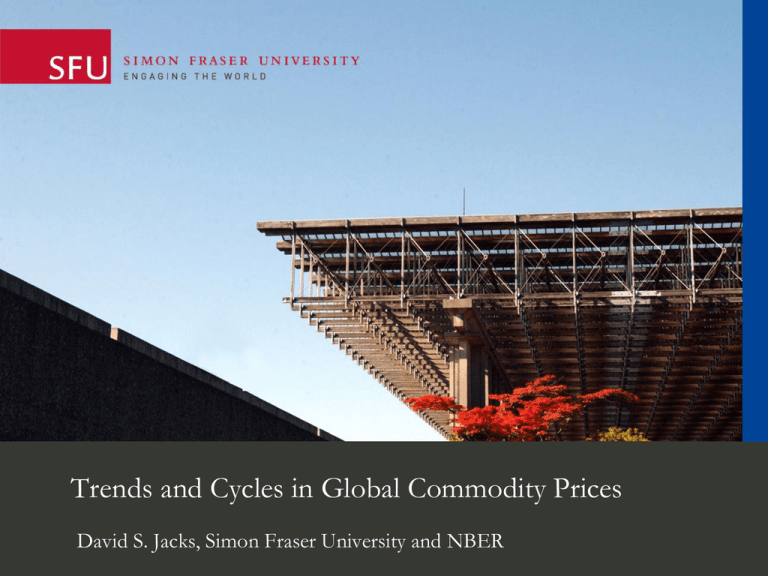
Trends and Cycles in Global Commodity Prices David S. Jacks, Simon Fraser University and NBER Paul Ehrlich, a biologist, won fame in 1968 for his book, “The Population Bomb”. Julian Simon, an economist, responded with his book, “The Ultimate Resource”. This gave rise to the Simon-Ehrlich wager, a bet on the direction of metal prices from 1980: Ehrlich lost…decisively and quietly. From boom to bust? Trends and Cycles in Global Commodity Prices 2 In the past few years, large increases in commodity prices have led to the view that the world is quickly running out of key materials. The necessary consequence of this scarcity is that economic growth must grind to a halt. But for others, this view is misguided as history suggests otherwise. From boom to bust? Trends and Cycles in Global Commodity Prices 3 My contention: we have to start with the idea that real commodity prices are cyclical. That is, real commodity prices have both trends and cycles which may be long in duration. Because of this, long-run patterns can be easy to miss because we confuse cycles for trends. From boom to bust? Trends and Cycles in Global Commodity Prices 4 But what are the sources of this cyclicality? (1) surging demand related to episodes of mass industrialization and urbanization; and (2) acute capacity constraints, in particular, for energy, metals, and minerals. The result being above-trend real commodity prices for years, if not decades on end. From boom to bust? Trends and Cycles in Global Commodity Prices 5 As cycles and trends can span decades, we need very long-run commodity price data. As cycles and trends can differ across goods, we need a wide range of commodity price data. I have collected annual price data for 40 commodities back to 1900, representing 8.72 trillion USD of production in 2011. New data on old prices Trends and Cycles in Global Commodity Prices 6 Prices drawn from the animal product, energy product, grains, metals, minerals, and soft commodity sectors. They are all expressed in USD given its role in global commodity markets. They are also deflated using the US CPI: a dollar from 2000—much less to say 1900— is not worth the same as a dollar in 2015. New data on old prices Trends and Cycles in Global Commodity Prices 7 Trends and cycles since 1900 Trends and Cycles in Global Commodity Prices 8 Trends and cycles since 1900 Trends and Cycles in Global Commodity Prices 9 Trends and cycles since 1900 Trends and Cycles in Global Commodity Prices 10 Thus, real commodity prices increased by roughly 0.75% per year in real terms from 1950. This decomposition also suggests that 2012 marked the peak of above-trend pricing. However, this “bird’s eye” view masks important differences across commodity type. Trends and cycles since 1900 Trends and Cycles in Global Commodity Prices 11 In particular, we need to distinguish between: 1.) “commodities in the ground”: energy products, metals, minerals; roughly speaking, non-renewable resources. 2.) “commodities to be grown”: animal products, grains, and soft commodities; roughly speaking, renewable resources. “In the ground” versus “To be grown” Trends and Cycles in Global Commodity Prices 12 “In the ground” versus “To be grown” Trends and Cycles in Global Commodity Prices 13 “In the ground” Trends and Cycles in Global Commodity Prices 14 “In the ground” Trends and Cycles in Global Commodity Prices 15 “To be grown” Trends and Cycles in Global Commodity Prices 16 “To be grown” Trends and Cycles in Global Commodity Prices 17 So, real prices for “commodities in the ground” rose by roughly 180% in real terms from 1950. While real prices for “commodities to be grown” fell by roughly 33% in real terms from 1950. And typically, cycles in commodities “to be grown” preceded by those “in the ground”… not so this time around. “In the ground” versus “To be grown” Trends and Cycles in Global Commodity Prices 18 But where are we left in terms of trajectories? Analysis of trends and cycles primarily a descriptive exercise, not one of forecasting. Critical role of 1998: lowest real commodity prices since 1933 as well as a turning point in all medium-run cycles but with lags. Critical role of China: largest urban migration in world history; 1990−2010 from 302 to 666 m. Future prospects Trends and Cycles in Global Commodity Prices 19 The transition from fixed capital accumulation to a consumption-based economy —and suburbanization—is tentatively beginning. If CPC is successful in this effort, likely to see: (1) increase in demand for goods “to be grown” and an inflection in long-run trend(?) (2) below-trend prices for goods “in the ground” and formation of new cycle in medium run(?) Future prospects Trends and Cycles in Global Commodity Prices 20 Thank you. Contact: David S. Jacks djacks@sfu.ca www.sfu.ca/~djacks Trends and Cycles in Global Commodity Prices 21



